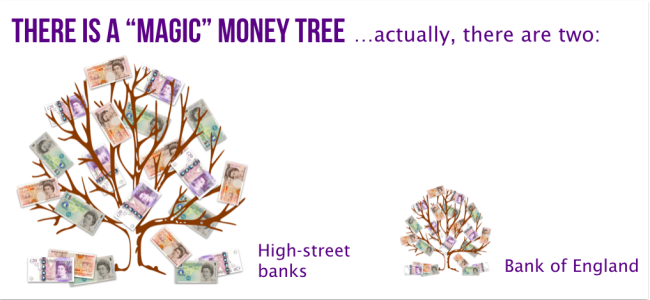
The Prime Minister Theresa May then used the same phrase in response to a nurse who hasn’t had a pay rise for 8 years. She said: “There isn’t a magic money tree that we can shake that suddenly provides for everything that people want.”
The thing is, there sort of is. Money can be created out of nothing, and her government has a lot of control over where it goes.
But sometimes when you start talking about how money is created, and how it works it can feel like opening a can of worms with no bottom. Not surprisingly, no one on the panel dared to pick up on it. And to be honest I don’t blame them. Only one out of ten politicians actually know how money is created. (See the results of a poll)
So what is the magic money tree?
Well as many Positive Money supporters know, there are two main money trees: commercial high street banks and the central bank, the Bank of England.The vast majority of money is created out of nothing, by banks when they make loans.
The Bank of England is currently running a programme where it creates £445 billion of new money, through a programme called Quantitative Easing (QE).
The main problem with these money trees is the vast majority of new money goes into financial and property markets, boosting asset prices, stock prices, and making the rich richer. While, very little is used to boost wages, create jobs, and invest in the things we need.
So there is a money tree, the question is whether it can be used more effectively? There is no reason why some of the money created through QE shouldn’t be invested through the government into things society really needs (find out more here).
Through our work we have found a tendency for politicians to see monetary policy outside of their knowledge base, thinking it is just something to be left to the central bank. Monetary policy has impacts which are of enormous political significance, and it is up to Parliament to scrutinise the wider effects of monetary policy on the economy and society. These comments by Theresa May and Amber Rudd were another sign politicians are stepping further away from this conversation.
So the government can spend what it collects in taxes, can borrow from financial markets, and can spend money created through the Bank of England.
Right, that sounds simple. It also goes against a lot of what we have been told over the last seven years since the crisis; i.e. that cutting government spending is inevitable, that we can’t afford the things we need.
So why is it like opening a can of worms?
Well, it is like opening a can of worms because money isn’t neutral and has many different aspects; economic, political, social, cultural, moral, and more. It has many different characteristics, depending on what we are doing with it – spending, saving, or lending it to others. For example, we could have a long conversation about the difference between money, credit, and debt.
Anthropologists like David Graeber understand the power of how the things we take for granted are socially constructed – e.g. money, and the idea that there is no magic money tree.
Pretending money isn’t complex is like pretending the Earth doesn’t go round the sun. Most academic economists, politicians, and policy makers, and other ‘people in power’ don’t really know what they think money is, which is fine, to an extent, but it becomes a problem if they don’t want to start to think about it.
Positive Money exists because we believe a public debate about how money is created, the problems it causes, and alternatives for reform is well overdue. The Bank of England has the power to create money, and we need to make sure that it’s used in the most effective way possible.
Although politicians are hard to engage with on monetary policy, we’ve demonstrated that despite money creation being a seemingly abstract and technical debate, there is a large appetite in the public to be engaged. We have over 60,000 supporters and that number is growing. Please join us by signing up in the form below.
And for now please share this video with your friends to help our politicians learn the truth about the magic money tree.
This comment has been removed by a blog administrator.
ReplyDeleteThanks...
ReplyDelete3D Prototype Printing Services